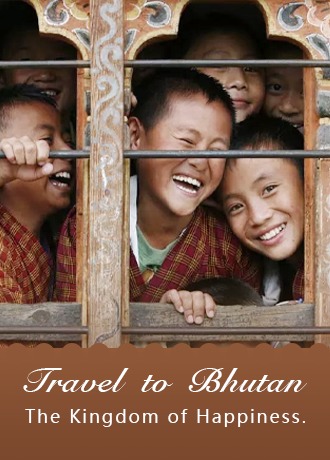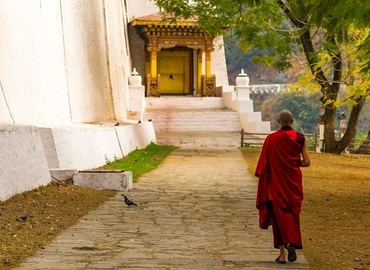Paro Tshechu — Bhutan’s Soulful Festival Celebration
- Amy
- Zuletzt aktualisiert : 18.11.2025
Nestled in the lush valleys of the Himalayas, Bhutan is a land where ancient traditions remain woven into everyday life. Among its many vibrant festivals, Paro Tshechu stands out as one of the most spectacular. Every spring, the quiet town of Paro transforms into a grand stage of color, music, and sacred dance. Locals and travelers alike, dressed in their finest traditional attire, and gather at the majestic Paro Dzong to witness this joyous and spiritual celebration - a remarkable opportunity to experience Bhutanese culture and enduring faith.
What is the Paro Tshechu Festival?
Paro Tshechu is one of Bhutan’s most famous and largest religious festivals, held annually in the picturesque Paro Valley. The term “Tshechu” literally means “the tenth day,” commemorating Guru Padmasambhava, the revered Buddhist master who introduced Tantric Buddhism to Bhutan in the 8th century.
During the festival, monks and lay performers present a series of sacred mask dances (Cham) and religious rituals in and around the Paro Dzong (Rinpung Dzong). For the Bhutanese, Tshechu is a time for socializing, seeking blessings, and cleansing past misdeeds; for visitors, it offers a rare chance to experience Bhutan’s spiritual devotion, cultural richness, and way of life up close.
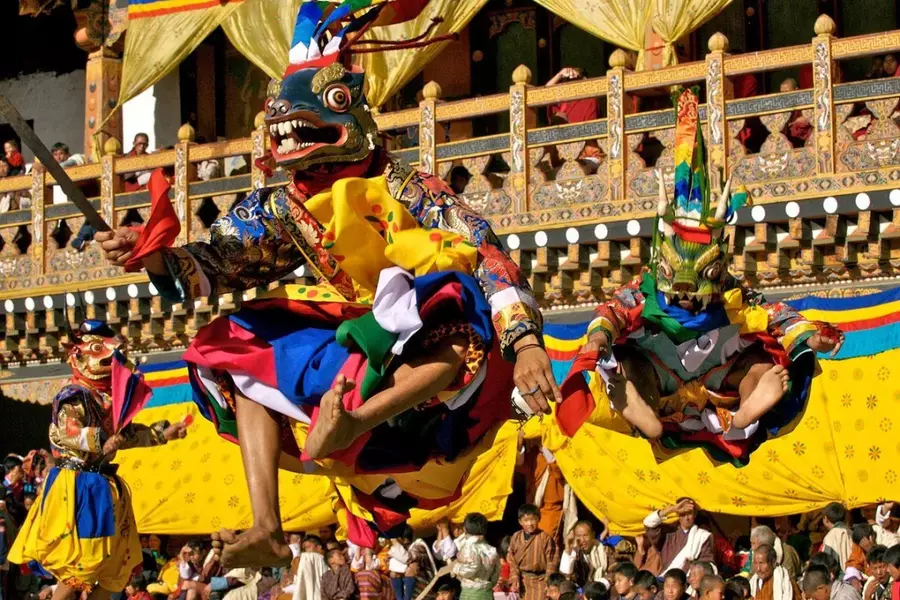
Time, Venue & Activities
Paro Tshechu festival takes place every spring, typically between March and April, with exact dates based on the Bhutanese lunar calendar. In 2026, the festival will run from March 29 to April 2, lasting five days.
The main venue of the festival is Paro Dzong, a fortress-monastery perched on a hillside along the Paro River. It is one of Bhutan’s most iconic religious and administrative centers. With its whitewashed walls, intricately carved windows, and panoramic views of the valley, it is a true architectural masterpiece. During the festival, vibrant prayer flags flutter in the breeze, the rhythmic sounds of drums and horns echo through the valley, filling the entire region with a vibrant yet reverent atmosphere.
Highlights
Atsaras (Clown Dance) — A Joyful Opening of Humor and Blessings
The festival often begins with the lively Atsaras, clowns wearing exaggerated masks, bright red noses, and colorful outfits. They weave through the crowd, playfully interacting with the audience, making everyone laugh. Their antics set a fun and light-hearted tone for the sacred dances to come.
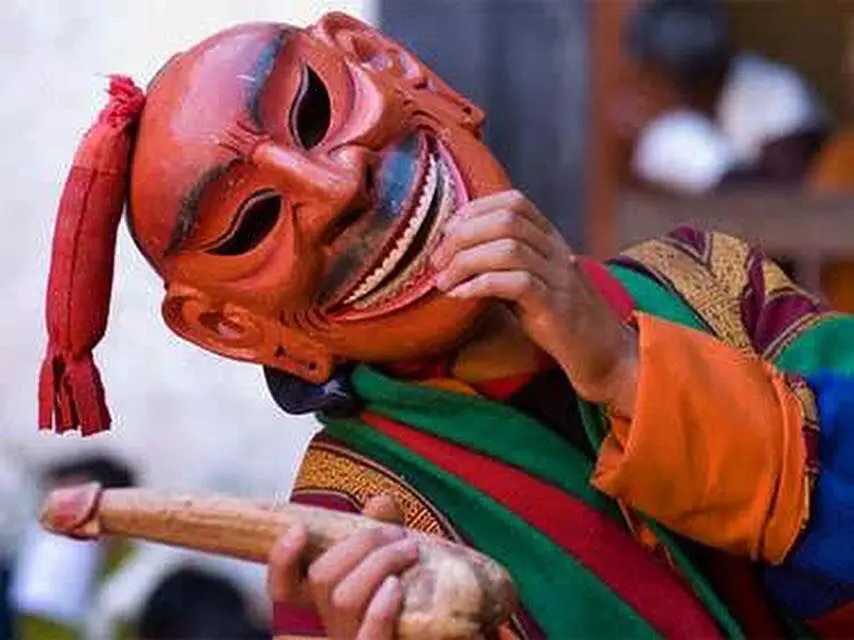
The term “Atsara” comes from the Sanskrit word Acharya, meaning “teacher,” and symbolizes wisdom and guidance. Their comical appearance reminds everyone of life’s impermanence and the many forms in which one might be reborn. During the rituals, they often tap spectators gently on the head with a wooden phallus, a symbolic gesture meant to ward off negativity and bring good fortune. These playful spiritual figures convey Buddhist teachings through humor, allowing laughter and blessings to coexist and infusing the festival with warmth and joy.
Cham Dance — A Sacred Performance of Myth and Spirituality
At the heart of Paro Tshechu lies the mesmerizing Cham Dance, performed by monks and lay dancers wearing vibrant silk robes and wooden masks that represent deities, protectors, and demons. As drums, cymbals, and long horns resonate through the air, the performers spin and move in powerful, rhythmic motions, bringing this spiritual tradition to life.
The dances draw inspiration from the legends of Guru Rinpoche subduing evil spirits and spreading the Dharma, portraying the timeless struggle between good and evil, wisdom and ignorance. Each performance carries a profound symbolic meaning, with names such as “Dance of the Lords of the Cremation Grounds (Durdag Cham), Dance of the Terrifying Deities (Raksha Mangcham), and the Dance with Noblemen and Ladies (Ging Tsholing Cham). Every gesture holds significance—the drumbeat symbolizes the triumph over evil, the sword represents cutting through obstacles, and the handbell awakens beings from ignorance.

Sunlight glints off the golden masks and colorful robes. It transforms the entire Paro Dzong into a solemn and mystical stage. It is believed that witnessing these sacred dances purifies the mind, accumulates merit, and bestows blessings and spiritual insight.
Thongdrel Unveiling — A Sacred Moment at Dawn
The climax of Paro Tshechu festival occurs at dawn on the festival’s final day. As the first light of morning appears, a massive silk thangka, about 30 meters long and 20 meters high, known as the Thongdrel (meaning “liberation upon sight”), is slowly unfurled on the outer wall of the monastery.
The Thongdrel depicts Guru Padmasambhava, along with various Buddhas and Bodhisattvas. It is briefly displayed outside the monastery. Devotees wear their finest traditional attire, hold khadas, and pray as drums, horns, and chants fill the valley. Simply seeing the Thongdrel is believed to bring blessings and spiritual liberation. Pilgrims from all over Bhutan gather before sunrise, eager to witness this sacred sight. In that moment, faith, awe, and joy intertwine, and the valley is enveloped in a profound sense of sacred serenity.
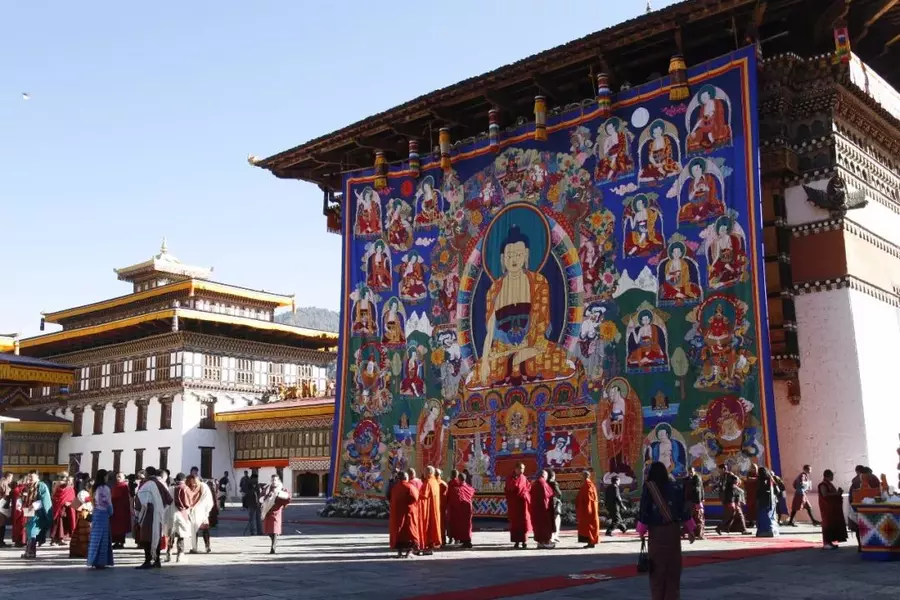
A Festival for Everyone — A Feast for the Senses and Soul
Paro Tshechu is not only a religious festival but also a vibrant cultural celebration for the entire community. Crowds fill the festival grounds, and the air is rich with the aroma of incense and traditional Bhutanese foods — Ema Datshi (chili and cheese stew), Suja (butter tea), and honey rice cakes sizzling over open fires. Stalls are lined with exquisite handicrafts, where artisans showcase centuries-old mask-making and weaving traditions, offering a glimpse into Bhutan’s enduring artistic heritage.
Everywhere, colors come alive. Swirling costumes of the dancers, fluttering prayer flags, and joyful crowds together create a lively festival tableau. As evening falls, bonfires are lit. Visitors can join locals in singing and dancing, soaking in the warmth and energy of the celebration. If you are lucky, you may even see the King's presence as he joins the people for the festivities.
For Bhutanese people, Tshechu is not just a ritual for seeking blessings but also a precious time to strengthen community bonds and preserve cultural memory.

Suggested 7-Day Itinerary
Want to experience Paro Tshechu and enjoy the stunning Himalayan scenery? This seven-day journey perfectly combines the festival celebration with valley exploration.
Day 1: Arrival in Paro – Explore the charming town.
Day 2: Paro to Thimphu – Visit the National Museum, the Institute for Zorig Chusum (School of Arts and Crafts), the Textile Museum, the Folk Heritage Museum, and the National Memorial Chorten.
Day 3: Thimphu to Punakha – Stop at Dochula Pass, visit Lobesa Village, and explore Chimi Lhakhang (Fertility Temple).
Day 4: Punakha to Paro – Visit Punakha Dzong en route, and enjoy Atsaras and Cham dance performances at Paro.
Day 5: Paro Tshechu – Witness the sacred Thongdrel unveiling and take part in festival activities.
Day 6: Hike to Paro Taktsang (Tiger’s Nest Monastery) – Enjoy stunning panoramic views of Paro Valley.
Day 7: Departure
Travel Tip: Flights and accommodations in Paro can get booked up quickly during the festival seasons, so it’s best to book 3 to 6 months in advance.

Frequently Asked Questions (FAQ)
Q: When is Paro Tshechu celebrated?
A: Paro Tshechu is usually held in March or April, depending on the Bhutanese lunar calendar. The festival lasts five days, with the final day featuring the sacred Thongdrel unveiling.
Q: Where does the festival take place?
A: The festival is held in the courtyard of Paro Dzong, one of Bhutan’s most beautiful fortress-monasteries. Tshechu festivals are also celebrated across Bhutan, including in Thimphu and Punakha.
Q: Do I need a ticket or permit to attend?
A: There’s no separate ticket for the festival, but all international visitors must book their Bhutan trip through a licensed tour operator as per Bhutan’s tourism policy.
Q: What is the highlight of Paro Tshechu?
A: The most anticipated event is the Cham Dance, a series of sacred mask dances performed by monks and laymen. The final day’s Thongdrel unveiling at dawn is considered the most sacred moment.
Q: Can I take photos or videos during the festival?
A: Photography is generally allowed, but visitors should be respectful, avoid blocking views, and never use flash inside temples.
Q: What should I wear?
A: Dress modestly and comfortably. Bhutanese people usually wear their national dress, and visitors are encouraged to wear long sleeves and avoid revealing clothing.
Q: Can I join the Cham dancers?
A: No. The dances are sacred and may only be performed by trained monks or performers.
Q: What time does the Thongdrel unveiling happen?
A: It takes place at dawn on the last day of the festival, usually around 3–4 a.m. Locals gather before sunrise to receive blessings by viewing the sacred silk scroll.
Q: How can I best experience the festival as a visitor?
A: Arrive early to find a good viewing spot, bring warm clothes for the morning, and enjoy interacting with locals—they are often happy to explain the stories behind the dances.
Q: Can I buy food or souvenirs at the festival?
A: Yes! Stalls around Paro Dzong sell local snacks like Ema Datshi, butter tea, and sweet rice cakes, as well as handmade crafts and textiles.
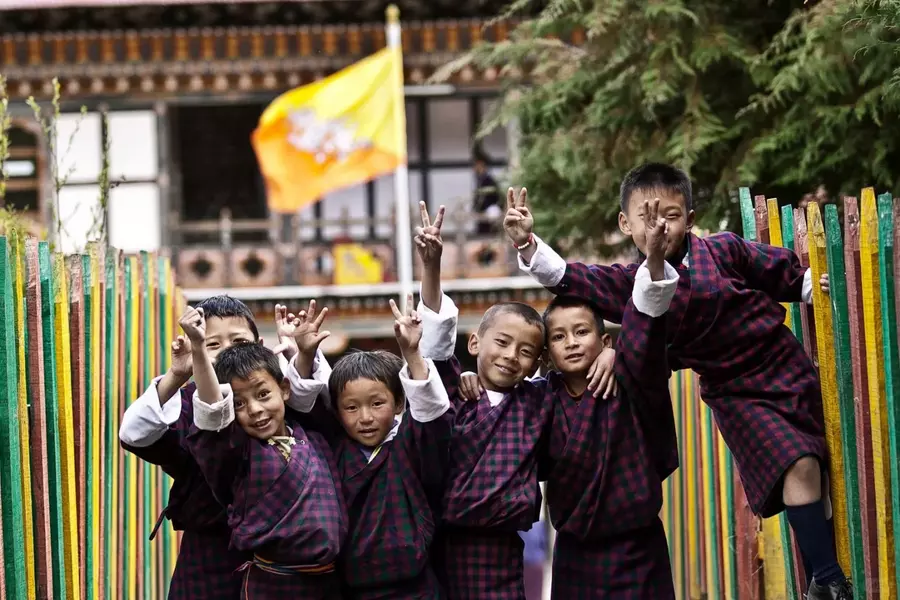
Conclusion
Paro Tshechu is more than a festival — it is a vivid expression of Bhutanese faith, art, and community. From sacred mask dances to the awe-inspiring Thongdrel, every moment offers a deeper connection to Bhutan's spiritual heart. If you're dreaming of experiencing this unforgettable celebration, feel free to reach out. We look forward to welcoming you in the spring!
Antwort per E-Mail innerhalb von 0,5–24 Stunden.


